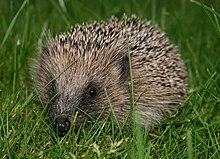Nocturnal animals
Nocturnal (Latin: nox - night, darkness)[1] animals are animals which are mainly active during the night.[2] They hunt or feed during the night, and sleep during the day. Diurnal animals do it the other way around.



Crepuscular animals are mostly active near dawn, dusk, and sometimes when the full moon throws light. Domestic cats hunt mice and voles mostly at this time.
Cathemeral animals are equally likely to be awake and active at any time of day or night.
Many nocturnal animals have good night vision. Their large eyes may be highly reflective when a bright light flashes on them. Owls and bats are typical nocturnal predators. More specifically, they have a larger cornea relative to their eye size than diurnal creatures. This increases their visual sensitivity in low-light conditions.[3]
Examples of nocturnal animals
changeReferences
change- ↑ Collins Pocket Latin Dictionary (First ed.). HarperCollins. 2008. p. 230. ISBN 9780007263745.
- ↑ "Nocturnal". BBC. Archived from the original on 2018-01-05. Retrieved 2011-04-25.
- ↑ Hall, M. I.; Kamilar, J. M.; Kirk, E. C. (2012). "Eye shape and the nocturnal bottleneck of mammals". Proceedings of the Royal Society B: Biological Sciences. 279 (1749): 4962–4968. doi:10.1098/rspb.2012.2258. PMC 3497252. PMID 23097513.